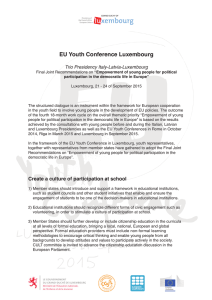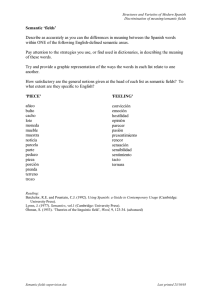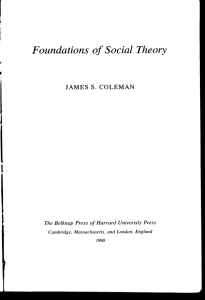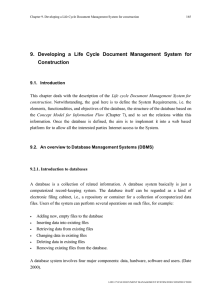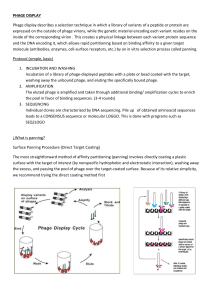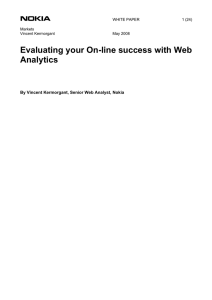A system to extract social networks based on the
Anuncio
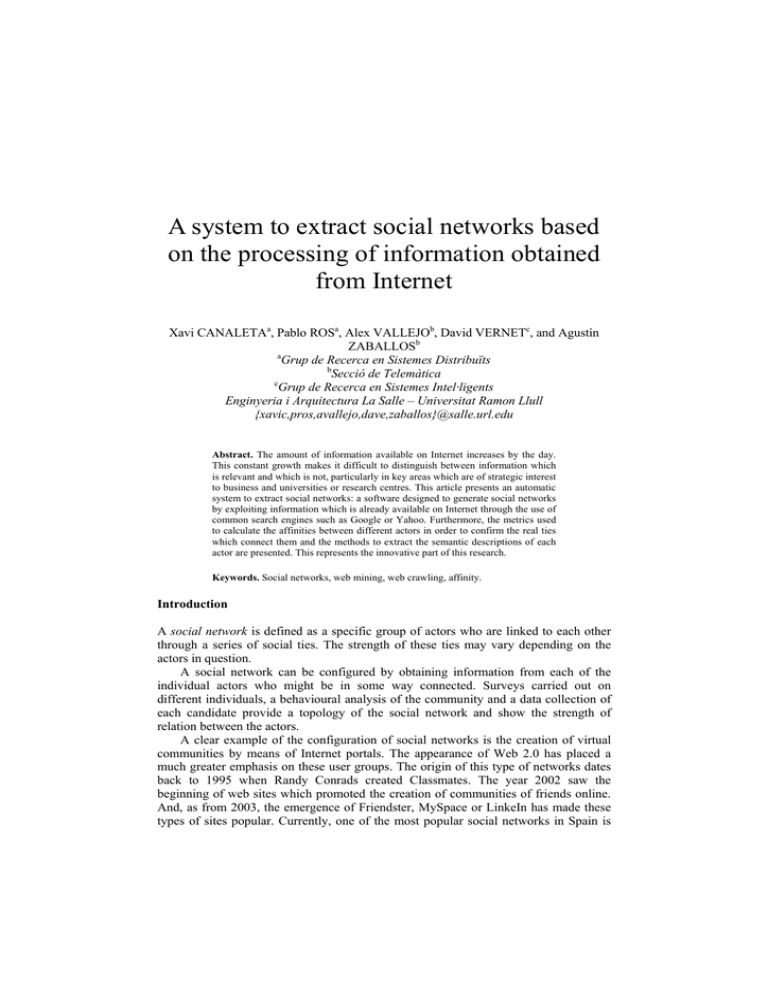
A system to extract social networks based
on the processing of information obtained
from Internet
Xavi CANALETAa, Pablo ROSa, Alex VALLEJOb, David VERNETc, and Agustín
ZABALLOSb
a
Grup de Recerca en Sistemes Distribuïts
b
Secció de Telemàtica
c
Grup de Recerca en Sistemes Intel·ligents
Enginyeria i Arquitectura La Salle – Universitat Ramon Llull
{xavic,pros,avallejo,dave,zaballos}@salle.url.edu
Abstract. The amount of information available on Internet increases by the day.
This constant growth makes it difficult to distinguish between information which
is relevant and which is not, particularly in key areas which are of strategic interest
to business and universities or research centres. This article presents an automatic
system to extract social networks: a software designed to generate social networks
by exploiting information which is already available on Internet through the use of
common search engines such as Google or Yahoo. Furthermore, the metrics used
to calculate the affinities between different actors in order to confirm the real ties
which connect them and the methods to extract the semantic descriptions of each
actor are presented. This represents the innovative part of this research.
Keywords. Social networks, web mining, web crawling, affinity.
Introduction
A social network is defined as a specific group of actors who are linked to each other
through a series of social ties. The strength of these ties may vary depending on the
actors in question.
A social network can be configured by obtaining information from each of the
individual actors who might be in some way connected. Surveys carried out on
different individuals, a behavioural analysis of the community and a data collection of
each candidate provide a topology of the social network and show the strength of
relation between the actors.
A clear example of the configuration of social networks is the creation of virtual
communities by means of Internet portals. The appearance of Web 2.0 has placed a
much greater emphasis on these user groups. The origin of this type of networks dates
back to 1995 when Randy Conrads created Classmates. The year 2002 saw the
beginning of web sites which promoted the creation of communities of friends online.
And, as from 2003, the emergence of Friendster, MySpace or LinkeIn has made these
types of sites popular. Currently, one of the most popular social networks in Spain is
Facebook. But the extracting system of these classic networks is not automatic. That is,
the information required from each actor is provided by the individual himself.
The purpose of our line of work is that the extracting system of the social network
is automatic. The information required from each actor is provided by the system
which is fed in an automated form by Internet to compile previously stored data. The
main difficulty lies is in ensuring that the information extracted from each actor is of
good enough quality. To achieve this, we have to address the problems related to the
immense quantity of information which is difficult to classify [1], to the difficulty of
identifying the actors [2], and the use of appropriate formulae to connect the actors of
the social network to establish corresponding degree of affinity.
The remainder of this paper is structured or organized as follows. Section 1
provides the related work in this area. Section 2 describes our system called SNex and
the extraction process. Section 3 is about the visualization of the social network.
Section 4 presents the results and conclusions and, finally, Section 5 describes the
future work.
1. Antecedents
The first system dedicated to the automatic extraction of information was the Referral
Web by Kautz, Selman, and Shah [3] in 1997. This system was designed to extract
social networks through the search engine Altavista. The social network generated was
ego-centric, i.e. it was centred on a determined individual. The basic idea of Referral
Web is based on the theory of the six degrees of separation and the list of potential
individuals related to the original actor was refined using the Jaccard coefficient [4] to
obtain the affinity calculations. The main problem was the ambiguity of the names and
an attempt was made to resolve this by adding extra fields for the user to clarify names.
A more recent system (presented in the sector) is that of Flink de Mika [5], which
provides an in-depth study of the conclusions of Referral Web and improves with
additional functions. The architecture of Flink is divided into three layers: data
acquisition, storage and visualisation. The system was capable of visualising social
networks of semantic network communities. The data obtained was from the web, from
the FOAF profiles, from emails and from published articles. The web-mining process
employed by Flink is similar to that of the Referral Web and it also uses the Jaccard
coefficient [4].
Further work worth mentioning is Polyphonet by Hamasaki and Matsuo [6], also
based on [3]. The system works from a list of names by extracting the social network
related to the data which the search engine Google provides. Unlike the previous
systems mentioned, Polyphonet uses the Overlap coefficient to calculate the affinity
between actors. Polyphonet also incorporates methods to detect the type of relation
between individuals, which might include co-authoring, participation in joint projects,
etc. It also tries to improve scalability by reducing the number of hits on the search
engine in order to reduce the computational costs of the extracting system.
The work carried out by De la Rosa and Martínez Gasca [2], which analyses the
results of Polyphonet and Flink, should also be highlighted. A methodology to extract
social networks is presented where electronic mails of the hits on the search engine are
used to construct the extraction process.
SNex, the system presented, is a continuation of their most recent lines of research.
On the one hand, the extracting system is fed by the information obtained from the hits
on Google and Yahoo, based on the Polyphonet models. On the other hand, the base for
information searches is based on the emails of the actors, as proposed by De la Rosa [2].
We must also consider the scalability parameters to optimise temporary costs. In the
system, any of the coefficients described in the previously mentioned works can be
employed to calculate affinities. Furthermore, the system incorporates new metrics
which can be used to assess the affinity between actors by referring to the semantic
descriptors extracted from the information obtained from Internet. This innovating
aspect differentiates the system from the previously mentioned works.
2. Description of the System
The extraction process of a social network has three clearly differentiated phases:
1.
2.
3.
Web crawling: tracks all the information available an actor. The crawler takes
advantage of the capacity of existing search engines to carry out this process.
Web mining: extraction process, which uses the information gathered from
Internet and the semantic content of each actor as its starting point. New actors
linked to the original actor who will in turn expand the social network are
obtained from this information
Visualisation: navigation tools which enable us to browse on the social web
and to consult all the stored information.
The typology of the social networks (researchers who usually belong to a
university) to be extracted has been restricted in this application, as have the search
techniques and the type of content to be used in the web mining process.
2.1. Web Crawling
The first step when making a query on the search engines is to determine the access
technique in order to carry out a consultation. Two search engines were used in this
work: Google and Yahoo. The access to the search engine Yahoo was made through its
API [7]. In the case of Google queries were made directly through the search engine
and a parser was created with the results.
Once access to the search engines had been prepared, the next step was to make
the queries. The ambiguity of the results of the searcher when it operates with names
and surnames was affirmed. The previously mentioned studies, [5, 6], attempt to
resolve this problem with different techniques. In the case of Polyphonet, the name of
the actor and keywords to differentiate one actor from another are added. However,
given the research environment, this technique would not be considered a valid solution
since, on one hand, it involves finding out information about the actor (something
which is not always possible when we are dealing with an expansion of the social
network) and, on the other, in tests carried out, the keywords used for the main actor
did not always succeed in eliminating ambiguity.
One approach to resolve the problem is that described by De la Rosa [2] which
uses the actor of the email as an identifier. The results obtained by the searcher in the
tests carried out match the requested actor 100%.
Finally, an attempt was made to restrict the information from Internet to that which
was strictly relevant to the social network and we aimed to reduce the results which do
not provide such information. Information of interest to researchers in the academia is
found in articles and published work (academic papers). Information on the areas in
which they develop their work and further information about the subjects themselves
can be found in such articles.
This type of document can often be found as published works in Internet and is
usually in PDF format due to its portability. At the moment this affirmation may well
be true. However, it is nevertheless limited to the majority of subjects concerning
Computer Science and not necessarily the case for the rest of the university community.
It is expected that advances in Information and Communication Technologies (ICT)
will make articles such as the aforementioned on any subject matter available in the
near future. Therefore, taking advantage of the parameters of the search engines, the
only information from PDF documents will be retrieved.
2.2. Web Mining
Data extraction of the actors is the most crucial point of the process. Posterior analysis
to determine the social network and the ties between the different actors will depend on
this stage. The objective is to obtain information on an actor (relation of the actor and
his semantic description through keywords) from the results obtained by the searcher,
from the list of URLs associated to the actor.
Figure 1. SNex 1.0 configuration environment
The mining process has different stages: social network expansion, extraction of
the semantic descriptions of the actors and, finally, the affinity calculations between the
different actors who form part of the social network. The decisions taken at each of
these stages are described below.
2.2.1. Social Network Expansion
The primary objective is to be able to expand the social network of the actor who is
being analysed. It is important to identify all the actors related to the individual to be
tested at this point. To achieve this list of PDF documents related to the individual
being tested which the searcher has sent back is referred to.
The first step is to transform the PDF file to a plain text document. The extraction
of candidates related to the actor being tested then proceeds. To undertake this task, the
decisions taken to identify the valid candidates on completion of the tests will be
described:
•
•
•
•
•
Every email which appears in the content of the document is converted into a
potential tie with the actor being tested
Every email which appears in the same line as the actor being tested will be
considered as being of greater strength, especially if they are co-authors
(affinity value equals 1)
The emails found near the email of the actor being questioned will be
considered as a direct relation (affinity=1). An e-mail at a distance of n
characters (configurable in SNex) from the actor being tested is considered as
near.
All the emails that belong to a document with a density of electronic mail
superior to d (configurable in SNex) will be penalised and will be of a lesser
importance when calculating the affinity with the actor being tested. In this
case, the affinity is multiplied by 0.2.
Finally, all the e-mails which appear in document containing more than m
emails (configurable in SNex) will be rejected. This measure ensures that
documents which contain sending lists which do not provide any relevant
information are deleted.
The application of these rules provides us with a list of candidates to expand the
social network towards the next level. The acceptance of these candidates as members
of the network will also depend on the affinity calculations made.
2.2.2. Extraction of Semantic Descriptions
The method used to extract the semantic content related to the actor being tested
employs well-known text mining procedures, based on the NLP-IR system (Natural
Language Process - Information Recovery).
The first step is to carry out a filter of the document in which all words, symbols
and characters not providing useful information are deleted.
The second stage is to delete all the stopwords (words which do not provide us
with any information, such as prepositions, articles, etc.) from the filtered text. To
achieve this, the document language must be known. A procedure based on the deletion
of stopwords has been developed. Previously created lists of stopwords generated from
the grammatical and linguistic study of [8] are used to count the number of stopwords
in the document. The highest number of stopwords found determines the language of
the document.
Finally, in the third phase, a stemmer (or grouper) is in charge of grouping together
words based on their root. Once this process has been completed, the lemmatisation, i.e.
the representation through a single term of all the inflected forms of a word [9] is
carried out. One of the first stemming algorithms was developed in 1980 by Martin
Porter [10], hence the name, “the Porter stemming algorithm.” In our system, we used
two stemming algorithms for Spanish and the Porter Stemmer for English [11] and the
stemming algorithm for Galician created by Penbad [12].
2.2.3. Affinity Calculations
Once a selection of candidates related to the actor being tested has been confirmed and
the semantic descriptions of the content of the associated documents extracted, it is
now time to decide whether the ties between the actors do really exist and if these ties
are strong enough to take into consideration.
The aforementioned works [5, 6], which analyse the number of documents which
link the different actors, have been used as a base to calculate the ratio capable of
quantifying the degree of affinity between actors. The possibility of calculating affinity
with the Jaccard coefficient [4], employed by Flink and Referral Web, the Overlap
coefficient, employed by Polphonet, as well as the Cosinus Coefficient have all been
contemplated in the system. The idea is to configure a weighted combination of the
different coefficients in order to obtain a more reliable affinity calculation, although at
present, the weights of the coefficients is still under testing.
The Jaccard coefficient gives the relation between the documents in which both
actors appear in reference to the number of documents written by one actor or the other
(either of the actors). The Overlap coefficient relates the number of documents jointly
written by X and Y, between the minimum of the results produced by actors X and Y.
The Overlap coefficient compensates for the limits of the Jaccard coefficient which
occurs when author X has many documents while Y has few but all of Y’s documents
are linked to X. The Jaccard coefficient provides a value which is of little relevance.
The Overlap coefficient rectifies this deficiency.
The Cosinus coefficient resolves the deficiencies of the Overlap coefficient which
is produced when, for example, actor X has 100 documents and actor Y has only one
document but this document is shared with actor/author X. If we apply the Overlap
coefficient the affinity is maximum whereas with the Cosinus coefficient it is 0.1.
n
Jaccard = X ∩Y
n X ∪Y
Overlap =
n X ∩Y
min(n X , nY )
Cos =
n X ∩Y
n X ·nY
From these affinity calculations and taking into account the criteria described in
section 2.2.1, the candidates to form part of the social network are filtered. To complete
this filter, an affinity value of 0.2 has been determined as a threshold.
Another type of affinity between actors is that which can be obtained through the
semantic descriptions extracted from each of the individuals who make up the social
network. This method enables us to link actors who may not share a high degree of
affinity but who do work in similar areas and consequently put them in touch with each
other.
To carry out this calculation, a list of keywords has been selected for each actor.
The keyword list is made up of keywords taken from their documents, selecting the
words with the highest occurrence in the text. In the SNex Version 1.0, the 10 most
frequent words are selected for each actor. This information enables us to develop the
search of a formula or metric which can be used to calculate the semantic affinity. The
keyword groups of each actor are defined to carry out this task.
LX={stem0,stem1,…,stemn}
LY={stem0,stem1,…,stemn}
An initial formula has been developed to calculate semantic affinity. The theory
behind it is based on the calculation of the number of keywords which coincide with
both actors. The keywords are weighted according to their occurrence. The importance
of a keyword depends on the number of times it appears in the content of an actor’s
documents.
n
∑ ∃{L X , LY }
i
Affinity = i =1
n
The expression ∃ (LXi,LY) gives 1 if the keyword i from the keyword list of actor
X is found in the keyword list of actor Y or 0 if does not exist. Therefore, if two actors
have 5 of the 10 keywords in common, their affinity will be 0.5.
Having analysed the tests carried out, it was concluded that a study of the
importance of the word within the whole social network was required. If there is a high
incidence of the word in the whole social network, this does not determine a greater
degree of affinity between two actors as it is present in the whole network.
Alternatively, if the word is common to two actors but not frequently used in the social
network, this indicates that the connecting link is due to the correlation of the semantic
interests of both actors which the rest of the social network do not share. Therefore the
initial calculation which weighted this factor has been modified and the following
formula obtained:
Occurrences ( L X )
n
i
∑ ∃{L X , LY } ⋅
i
i =1
GlobalOccurrences( L X )
i
Affinity =
n
By this means, if actors X and Y coincide in 5 out of the 10 keywords, but these
words are commonly used in the social network, the number of global occurrences will
be very high, which will make the factor reduce the affinity between actors.
3. Visualization
Although it is not the main focal point of this research, it is essential that the
environment for the presentation and navigation of the extracted social network is
friendly and usable. An environment in which results can be easily obtained will
facilitate future analysis and corresponding conclusions. Three functionalities have
been designed for this purpose:
•
•
Visualiser of the graph of an actor: this provides us with a vision of the social
network, showing the actor and the different ties he shares with other actors.
The keywords associated with the actor are also shown. The implementation
of this function is based on the work of Moritz Stefaner [13]
Tag cloud: the most relevant keywords of the whole social network are shown.
This allows for the filtering by the given words with matching actors.
These words are then used in subsequent filters carried out on the actors
•
Navigation panel: this enables us to analyse the various levels of the social
network and to consult the affinity coefficients of each actor as well as
providing information on the performance of the system in its searches and
data extraction.
Figure 2. Visualisation of the social network
4. Results and Conclusions
Firstly, a comparative study of the response time of the two search engines on which
SNex can currently consult information, Google and Yahoo, was carried out. The
response time for 100 queries on the Yahoo engine was 85.620 seconds (0.86
s/consultation), while for Google it was 43.480 seconds. Here we can see how the
response time of Google is much faster than that of Yahoo, almost half.
With reference to the method used to detect the language, tests on 81 PDF
documents were carried out and the percentage of matches was 96%. In fact, on
analysis of the three documents in which the language was wrongly identified, we saw
how this error was due to a coding problem related to the PDF format. Therefore we
can conclude that the detection method works correctly.
Turning to the reliability of the networks obtained by the automatic extraction
process, the fact that the test environment consisted of queries made by research
professors from our university centre should be underlined. The election of this
environment permits us to verify the results obtained by consulting with those involved.
The first tests were carried out on known authors and the results obtained were
absolutely correct. That is to say, the actors with a degree of co-authoring in the PDF
documents were found. This meant that none of the actors were eliminated from the
process given the fact that co-authoring implies a strong tie between actors.
Another of the tests carried out was realized with ralsina. This person was chosen
due to her productivity in research articles. A level 1 network was initially created with
93 related actors. However, many of these actors had no real ties with the candidate.
The reason for this as that co-authoring had not been penalised at this point and that
sending lists from PDF documents had been classified as co-authors of an article. The
results obtained were significant. From the 93 candidates, only 7 were actually actors
with real ties. Applying the Overlap coefficient, 14 ties emerged, while when the
Cosinus coefficient was applied only 6 were found. The results obtained with cosinus
are closer to the truth, if we consider that only one real tie was lost, while the Overlap
coefficient produced 8 additional “unreal” actors related to the main actor.
Another noteworthy consideration is that the very nature of the semantic affinity
formula is not commutative. For example, Affinity(X,Y) does not necessarily have to be
equal to Affinity((Y,X). This has been proven in the tests. Although it is true that it
might not seem logical at first, a series of tests demonstrated how the importance or
strength of the tie between two actors does not give the same result when analysed
from each of their different perspectives or roles within the social network. It may be
the case that actor X belongs to a social network simply because he is linked to actor Y
who forms part of the same network. In this case, the degree of affinity from actor X
towards Y should be high. Nevertheless, the degree of affinity from actor Y towards X
is not necessarily as relevant as in the previous relationship given that Y could be
linked to other actors who are more important to him than actor X.
This application has been developed with the adoption of a vision-controller model
which separates the layers of data, business logic and user interface. The SNex
application has been developed using the PHP programming language and the MySQL
database. With reference to system performance, the extraction system was extremely
slow at first. To resolve this issue, multithreading was incorporated into the system so
that several queries could be made on the search engines simultaneously. Response
time on the search engines was reduced. The results were then stored in the memory
cache and on hard disk to avoid redundant or repeated queries. This method resulted in
a drastic time reduction. At present, it usually takes between 100 and 350 seconds to
generate a level 1 social network.
5. Future Work
Focusing on SNex 1.0 and the results obtained, there are multiple future lines of
research whose goal is to improving performance levels of the social network
extraction system and to develop more precise methods to calculate affinity levels.
As far as web crawling is concerned, the possibility of testing the system with
several additional search engines is gaining ground. The possibility of using the results
obtained by the different search engines and assigning a weighted factor to each one is
also being considered. Another aspect to take into account is how to improve the search
techniques of the search engines.
The improvement strategies to work on the web mining stage are multiple. On one
hand, proposals have been made to widen the scope of the type of information which is
analysed. At present, only documents in PDF format are analysed but there are plans to
study whether the addition of other types of document (html, postcript, text, etc.) would
improve the quality of information and lead to better results in the social network.
In the area of extraction of semantic information, more complex algorithms are set
to be included in this area in order to obtain semantic abstractions, such as the use of
Wordnet at Princeton University.
Research and development into affinity calculations will continue and both
coefficients and semantic descriptors will be employed. In this area, the investigative
qualities of the researcher tend to be assessed and quantified by the number of
references made by other authors in their articles.
Acknowledgements
The authors would like to thank Enginyeria i Arquitectura La Salle (Universitat Ramon
Llull) for their encouragement and assistance, especially Lisa Kinnear for the linguistic
reviews of the paper.
References
[1]
[2]
[3]
[4]
[5]
[6]
[7]
[8]
[9]
[10]
[11]
[12]
[13]
R.S. Wurman, “Angustia informativa”, Prentice Hall, Argentina, 2002.
F. De la Rosa, R. Martínez, Sistemas de Inteligencia Web basados en Redes Sociales, Revista hispana
para el análisis de redes sociales, 12(9), 2007.
H. Kautz, B. Selman, M. Shah, The hidden web, The AI Magazine, 18(2), 27-36, 1997.
P. Jaccard, Distribution de la flore alpine dans la bassin de transes et dans vuelques regions voisines.
Bulletin de la societe Vaudoise des Sciences Naturelles, 241-272, 1901.
P. Mika, Flink: Semantic web technology for the extraction and analysis of social networks, Journal of
Web Semantics, 3(2), 2005.
M. Hamasaki, Y. Matsuo, J. Mori, Polyphonet: an advanced social network extraction system from the
web, Procedings of WWW2006, 2006.
Yahoo! developer Network, [online] available: http://www.developer.yahoo.com/search, May 2008
Departamento de Computación, Universidad de Neuchatel, UniNE at CLEF, [online] available:
http://members.unine.ch/jacques.savoy/clef/, June 2008.
D. Crystal, Diccionario de lingüística y fonética. Octaedro Editorial, 2000.
M.F. Porter, An algorithm for suffix stripping. Program, 130-137, 1980.
M.F. Porter, Snowball: a language for stemming algorithm. 1980.
M.R. Penabad, M.L. Moreda, Places, E. Vázquez, Algoritmo de stemming para el gallego.
Procesamiento del Lenguaje Natural. 154-160, 2005.
M. Stefaner, Relation Browser, [online] available: http://www.der-mo.net/relationBrowser/, June 2008.


